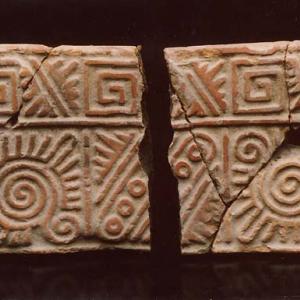The Aztec civilisation (1325-1521 A.D.)
The Aztec, one of the seven tribes of the Nahua (nomadic hunters and gatherers of northern Mexico and the southwest region of modern US) arrived at the end of the 12th century A.C. in the Central Mexican Plateau. They settled down in the marsh of Tezcoco lagoon and, after reclaiming the area, in 1325 they founded the capital city Tenochtitlán.
They had a highly stratified society divided into five social classes: the nobility, who held the political-military and religious power and owned private lands; the pochteca (the merchants); the artisans, including the tolteca, who were specialized in feather and gemstone works; the farmers; the slaves, prisoners of war or insolvent debtors. The emperor (the tlatoani) ruled over everyone with the assistance of a council elected by the twenty clans of the capital.
The Aztec adopted the complex calendar used in Mesoamerica and added to their astral deities (Huitzilopochtli, god of the Sun at the zenith; Tezcatlipoca, god of the Great Bear; Mixcoatl, god of the Milky Way) other deities who were already present in the previous or coeval cultures (for instance, the god Quetzalcoatl, venerated in Teotihuacán).
In 1521, with the arrival of the Spaniards guided by Cortés, the Aztec Empire succumbed to the Conquistadors and Tenochtitlán was destroyed; on its ruins Mexico City was later founded.
The 14th-century ceramics were quite rough; later, under the cultural and artistic influence of the populations with whom the Aztec came into contact, potters started producing more refined ceramics, characterized by elaborate decorations. The most common shapes are the three-legged vases and the conical cups with slips painted in brown-red colours and decorated with black and white geometric motifs, which were used to drink pulque.
The most important artistic production is stone sculpture: we can still admire monumental sculptures representing deities; cases engraved in relief (tepetlacalli) containing sacred objects; containers used to collect the hearts of the sacrificial victims (cuauhxicalli – eagle’s vases); big bas-relief monoliths (such as the Pedra de los Soles or Aztec calendar); three-dimensional zoomorphic and anthropomorphic sculptures.
Anthropomorphic head (fragment) (Aztecs/ Mixtecs), Mexico

Anthropomorphic head (fragment) (Aztecs/ Mixtecs), Mexico

Anthropomorphic head (fragment) (Aztecs/ Mixtecs), Mexico

Anthropomorphic head (fragment) (Aztecs/ Mixtecs), Mexico

Fragment of pintadera (Mexico)

Fragment of pintadera (Mexico)
Fragment of pintadera (Mexico)

Fragment of pintadera (Mexico)
Anthropomorphic vase (mutyle), (Aztecs/ Zapotecs), Mexico

Anthropomorphic vase (mutyle), (Aztecs/ Zapotecs), Mexico
Anthropomorphic vase (mutyle), (Aztecs/ Zapotecs), Mexico

Anthropomorphic vase (mutyle), (Aztecs/ Zapotecs), Mexico
Pendant shaped as a bird’s head (Mexico)

Pendant shaped as a bird’s head (Mexico)

Pendant shaped as a bird’s head (Mexico)

Pendant shaped as a bird’s head (Mexico)

Skull shaped Pendant (Mexico)

Skull shaped Pendant (Mexico)

Skull shaped Pendant (Mexico)

Skull shaped Pendant (Mexico)

Pendant shaped as a bird’s head (Mexico)

Pendant shaped as a bird’s head (Mexico)

Pendant shaped as a bird’s head (Mexico)

Pendant shaped as a bird’s head (Mexico)

Fragment of pintadera (Mexico)

Fragment of pintadera (Mexico)
Fragment of pintadera (Mexico)

Fragment of pintadera (Mexico)
Shrapnel and arrowheads (Aztecs?), Mexico

Shrapnel and arrowheads (Aztecs?), Mexico

Shrapnel and arrowheads (Aztecs?), Mexico

Shrapnel and arrowheads (Aztecs?), Mexico

Shard of obsidian (Aztecs?), Mexico

Shard of obsidian (Aztecs?), Mexico

Shard of obsidian (Aztecs?), Mexico

Shard of obsidian (Aztecs?), Mexico





